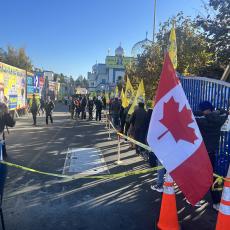Geothermal ambitions clash with the indignenous peoples of an Indonesian village.
This essay and the lead image were produced and published by Asia Democracy Chronicles.
When Agustinus Tuju heard that there would be a geothermal plant expansion in his village in Flores Island in eastern Indonesia, he swore he would defend his people’s ancestral lands even if meant giving up his life.
That was in 2022. Today Tuju, now 53, and hundreds of other members of the Poco Leok indigenous community in Lungar village continue to be against the expansion. They say that not only was expansion drawn up without consulting the residents, its implementation would also harm the environment and rob them of their livelihood.
“We knew about it only after the people claiming to be from the company came to our village to measure our land,” says Tuju. “We’ll never sell our land.”
Indonesia sits on the Ring of Fire, a formation of active volcanoes along the Pacific Ocean. This has given the country the world’s largest geothermal energy potential of 29 gigawatts (GW), or 40 percent of the world’s total resource.
Electricity generated from geothermal plants has grown exponentially in Indonesia in the last decade or so: from just 1.3 GW in 2013, to 2.5 GW in 2023 through 18 geothermal plants across the country.
Geothermal energy is considered to be among the cleanest power sources largely due to its low carbon and particle emissions compared to fossil fuels. Because it uses the Earth’s underground heat, it is reliable and always available. Worldwide, Indonesia is now the second largest nation to have installed geothermal energy, bested only by the United States.
Yet while the ideal spots to build geothermal plants in Indonesia are usually in remote areas, these are also often populated – and PT PLN, along with other power companies, is apparently failing to gain the support of local residents for its geothermal projects. That may well thwart Indonesia’s ambitions for geothermal energy to help power its transition to renewable energy, which President Prabowo Subianto has said could be 100 percent complete by 2035.
In fact, the reasons raised by the Poco Leok community for mounting a protest are the same as those of several other areas where there are existing or planned geothermal projects: no prior consultations with local residents, the environmental and health risks posed by such ventures, and probable loss of livelihoods.
Residents in many areas that have or are targeted for geothermal projects say that they knew of these only after the plans were already ready for implementation, and sometimes only after surveyors wanting to look at the project site showed up.
Water polluted and drained
In 2021, the central government issued Government Regulation No. 22, which stipulates public participation in state or private projects, especially prior to issuing environmental impact analysis. Poco Leok locals say that PT PLN did not heed this legal requirement. But Dede Mairizal, senior manager at East Nusa Tenggara PT PLN, insists, “We actively work with the local government to ensure the livelihood of the local community is protected. We respect customary traditions and the environment.”
As for the risks posed by the projects, several sites hosting geothermal plants have already experienced such challenges and remain exposed to them. The Ulumbu plants that are supposed to be expanded in Tuju’s village, for example, have been the source of complaints for years, with locals blaming these for decreasing crops, particularly coffee and avocado. And just last year, residents said that they developed headaches and nausea while the plants were undergoing maintenance, leading them to suspect that toxic gases may have been emitted.
In Dieng, Central Java, researchers have found hydrogen sulphide in the air to exceed safe limits. Dieng residents have also complained of water shortage, with the little water available often smelly and polluted. In Bogor Regency, several villages reported water scarcity, which they blamed on the Mount Salak geothermal project there, according to the environmental nonprofit WALHI.
A similar case has been reported in the Mataloko geothermal project, some 140 kms from Poco Leoko, as farmers complained that lack of water, along with hot mud eruptions, has led to crop failures.
Geothermal projects are “thirsty,” says Beyrra Triasdian, renewable energy researcher at the Jakarta-based think tank Trend Asia. “During the drilling process, they require a large amount of water, which is usually taken from water sources where local communities depend on.”
That thirst doesn’t end once the plants begin operating. According to the U.S.-based nonprofit Union of Concerned Scientists, geothermal plants can require between 1,700 and 4,000 gallons (6,425 and 15,142 liters) of water per megawatt (MW)-hour, depending on the technology used.
The Mining Advocacy Network (JATAM), an environmental NGO based in Jakarta, meanwhile notes that even though the Mataloko project is still in its development stage, the locals’ health is already affected as the venture’s activities have exposed them to sulphur and other toxic gases, including ammonia and hydrogen sulphide.
“We learned from other projects in other regions,” says 30-year-old Servasius Masyudi Onggal, who. like Tuju, is from the Poco Leok Indigenous community. He worries that his community will suffer a similar fate “if the government pushes this project forward.”
For generations, he says, the Indigenous communities of Poco Leok have relied on their customary land and forest to grow coffee, cloves, vegetables, fruits, and other commodities, which enable parents to send their children to universities. They are not about to give that up for additional energy that central and regional authorities say Flores Island needs. Indeed, existing and potential mining ventures on the island are likely to be the major users of that power.
‘Geothermal island’
Flores was declared a “geothermal island” by the central government in 2017. Across the island, seven geothermal working zones have been declared by the Ministry of Energy and Mineral Resources: aside from Ulumbu and Mataloko, there are also Sokoria, where a plant has been operational since 2023, and Wae Sano, Oka Ile Ange, Atadei, and Nage. In all, these areas could have a potential capacity of 120 MW.
The Ulumbu geothermal plants, up and running since 2011, have a 10-MW combined capacity. PT PLN believes it could bring that up to 50 MW with the planned expansion, for which it has already secured almost 13 hectares of land, bought for a total of IDR 120 billion ($720,000) from 68 individuals.
PT PLN says it began buying land after securing approval from Herybertus Nabit, regent of Manggarai, where Poco Leok is located. The Manggarai official is currently facing a civil lawsuit courtesy of Tuju, representing the Poco Leok Indigenous community, for alleged intimidation, threats, and violence against demonstrators conducting a peaceful protest during World Environment Day last June.
That was not the first time protesters against geothermal projects in Flores Island had a violent confrontation with authorities. In October last year, hundreds of members of the Poco Leok Indigenous community were involved in a scuffle with security personnel who were accompanying PT PLN surveyors. Dozens of people wound up injured while four – among them a journalist – were arrested. No charges were eventually filed against those arrested, but activists and residents say that the arrests meant authorities were “criminalizing” the people’s protest actions.
In 2023, several Poco Leok villagers protesting the presence of surveyors on their customary land were also beaten up by police. Manggarai District Police Chief AKPB denied that the police “repressed” the protesters. But he told the local Floresa publication that they were there to protect a project that was part of a national strategic program, which meant the police had the “responsibility and duty to secure” its implementation.
Resistance still on
Since the expansion plan was announced three years ago, the Indigenous peoples in Poco Leok have staged no less than 30 community watches and set up camps to halt surveyor teams. The locals have enjoyed support from rights and environmental activists, both individuals and groups.
Umbu Wulang Tanaamahu Paranggi, executive director of WALHI East Nusa Tenggara, comments, “The expansion project will threaten the living space for Indigenous People and water source important for the local communities.”
Church leaders have also stepped up to express their opposition to the geothermal projects in Flores Island. Although Indonesia is predominantly Muslim, the island’s population of nearly two million are mostly Roman Catholics.
The development of new geothermal projects in Flores has been suspended since April, following the meeting of East Nusa Tenggara Governor Emanuel Melkiades Laka Lena with Ende Archbishop Paulus Budi Kleden.
Kleden had first spoken up against geothermal projects in Flores and Lembata islands last January. According to a report by the Church-run Radio Veritas Asia, a pastoral letter released two months later and bearing the signatures of Kleden and the bishops from the five Ende dioceses acknowledged the need for development but cautioned against “unwise exploitation” that “harms the environment, food security, social balance, and cultural sustainability.”
Governor Lena promised a review of the projects. But the findings of the task force created to do the review have been met with dismay.
Another Radio Veritas report said that the Alliance Involved with Victims of Geothermal Flores (ALTER BKGF) – a network of youths from Catholic parishes, student leaders, religious justice commissions, and rights groups – called the findings biased and opaque, as well as criticized the task force’s composition, which had no women or civil society representatives.
Moreover, ALTER BKGF said, the task force seems to have sought out views only from project supporters, thereby producing false claims of “broad community support” for these.
But while Flores Island Indigenous peoples and the Church remain determined to stop any more geothermal projects there, the central government and local authorities are just as bent on achieving their energy plans.
Although there are pessimists who say that Prabowo’s goal of full clean energy by 2035 would be hard to meet, Fabby Tumiwa of the Institute of Essential Services Reform (IESR) says that it only shows the president’s “strong commitment and determination” to Indonesia’s transition to renewable power.
Based on the National Electricity General Plan 2025-2060, Indonesia is targeting a 29.4-percent share of clean energy in the national power mix by 2034. PT PLN, however, has set a higher target figure of 34.3 percent for the same year.
Geothermal energy’s share in the mix is currently six percent; the government is said to be keen to see this rise to eight percent in five years.
Geothermal energy has been championed as a clean, renewable source necessary for energy transition away from fossil fuel, says Stanford University earth sciences professor Roland Horne. But he says that it is important that geothermal projects are done safely to prevent environmental impacts. He adds that it is also “a matter of engaging the community just to make sure that they have their opportunity to voice their concerns. They have to have the opportunity to see what the advantages are for them.”
Center for Economic and Law Studies Executive Director Bhima Yudhistira agrees that geothermal energy plays a significant role in transitioning away from fossil-fuel use. He adds, however: “The government must ensure that geothermal energy is not extracted using the same exploitative way [as those for] other commodities. This means respecting human rights and conducting thorough studies to ensure that communities are protected and nothing is harmed.”



